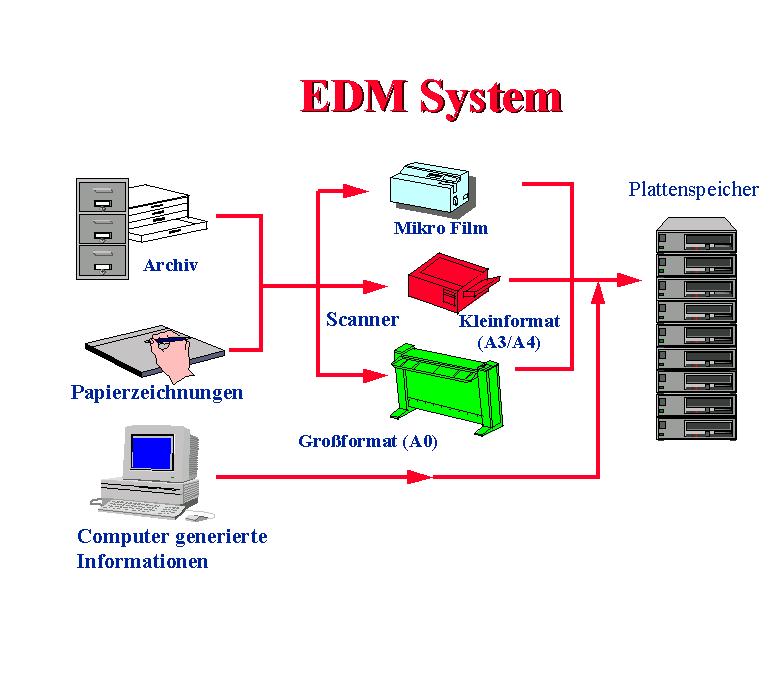|
|
|
| < Peter Michalicka > ... < A-4813 Altmünster / Austria > ... < +43 664 8719414 > |
Criteria for the digital drawing archive
What does it mean Elektronic Document Management System (EDMS) and how could the user decide which of the market solutions is the optimal variant for his application. The praxis has shown that often not all of the criteria of the project could be determined or with the time there are new possibilities or choices for the user. That means often the user should create an Electronic Archive and extend this archive later . The main topic is that an open solution with database import and export is to prefer before other systems. It is not mentioned the database dBase or SQL it is dependend of the internal administration, data or file structur of the application must be known so that it is possible to change later on between different systems.
The first step for an Electronic Archive is the inventory of the existing sheets sorted by the following criteria:
- Number of sheet sorted by size (A,B,C,D,E)
- Kind (Paper or Microfish) and quality of sheets
- Archiv-Sheets or Production-Sheets
Based on the inventory you could determine the total size of disc memoy.. The praxis shows with grupp 4 compression (e.g. TIFF G4) the following values:
- A size approx. 30 to 40 kB
- E size approx. 350 to 500 kB
The given values are based on a scan resultion of 300 dpi, but mention the size grows by square because 3 * 3 = 9 and 4 * 4 = 16 the means approximate a double data size if you scan with 400 dpi resultion. Which criteria determines scaning resolution and scanner type:
- smallest pen size within the sheet
- existing printers
- Quality of the sheet
If the smallest pen is 0.13 mm than you need 400 dpi and a smallest pen of 0.18 mm Linien needs only 300 dpi resolution. It also makes non sense to scan Asize sheets with 400 dpi and to print onto a 300 dpi laserprinter. Specialy on bad sheets or small pen width it is necessary that the physical resulution and the scanner quantity is good enough, because afterwards you cant repair anything. A quality controll after scanning by hand is allway necessary.

The second step is the integration of an EDMS into a network and there are the following needs:
- Informationsexchange (User / Groups)
- Access and View
- Integration of existing Software / Interfaces
- existing Hard- and Software
- Reproduction (Printing / Plotting)
Standardoffer for a ‘Digital Drawing Archiv’
1. Program Entry
1.1 User verification by Windows-Login
1.2 Access right by the user through local setup / PC
1.3 Different levels of rights (Write-, Read- and Execution)
1.4 A user definable entrymask
2. Database Access
2.1 ASCII-Interface for Import and Export to a SQL-Database
2.2 Field definitions within the database individual
2.3 User defined query mask
2.4 Different search criteria for database search
2.5 Full-Text-Search within the database possible
2.6 Database access onto 10000 to 100000 data sets, the resonse time is between. 2 and 6 seconds
2.7 File Formats for Rastergrafics (TIFF, RLC, RLE, PCX, GIF, Targa, JPEG)
3. Visualisation software
3.1 The view of an E size drawing needs between 5 and 60 seconds
3.2 Zoom functions
3.3 Measurement functions
3.4 Compare of drawings
3.5 Multiple document interface (Raster/Vektor Overlay possible)
3.6 Viewing of different Layers within CAD-Drawings
4. Print/Plot
4.1 All Windows supported interfaces
4.2 Automatic or manual scaling
4.3 Free defined drawing parts should be plotted
5. Data interfaces
5.1 CAD-Systemes (AutoCAD, MicroStation and/or HPGL/2)
5.2 Interface to WinWord/Word/Excel etc.
5.3 Import of Rastergrafic (Scan-Systemes, etc.)
5.4 Data import manually or as batch
6. Hardware/Software
6.1 The user PC's are Windows PC's.
6.2 Used Software-Modules are: RxIndex, RxView and OPM-Tools
6.3 Optical disk systems are possible
7. Our Know How
7.1 System Consulting - 1 Day
7.2 Systemintegration - 1 Day
7.3 Training of users - 1 Day
7.4 Support within a support contract
7.5 Software-Licenses for Windows Network